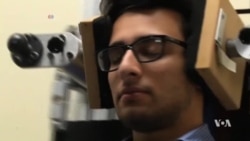It’s a sickening feeling — the dizziness, nausea and vomiting that comes with motion sickness. People have tried wristbands or taken anti-nausea drugs to prevent it, but often, nothing works.
Scientists at Imperial College London are working on a new device to counteract motion sickness, which occurs when the motion you sense with your inner ear is different from the one you visualize.
“You imagine being on a bicycle or motorbike. You go around the corner, you lean into the corner, which remains perfectly upright in physics,” said Michael Gresty, a motion sickness expert. But, he noted, “you don’t do that in a car. You don’t do that on a ship. You’re actually struggling to find out what is upright, and what’s the best way of dealing with it.”
The researchers said the device stops motion sickness by suppressing certain signals in the brain.
In the research, conducted in a hospital laboratory, volunteers sat in a motorized, tilting chair for about 10 minutes, experiencing the motions that make people ill. Then a mild electrical current sent through electrodes on the volunteers’ scalp caused the brain to suppress signals that affect the inner ear.
"We found that it took longer for the individual to develop motion sickness, and that they also recovered faster," researcher Qadeer Arshad said.
And there are no reported side effects. “These are very small amounts of electricity that you’re putting through the brain,” Gresty said.
The next step is to test the device outside the laboratory. The scientists hope a device that plugs into a smartphone and attaches to the scalp will be available within 10 years, saving a lot of people from the misery of motion sickness.








